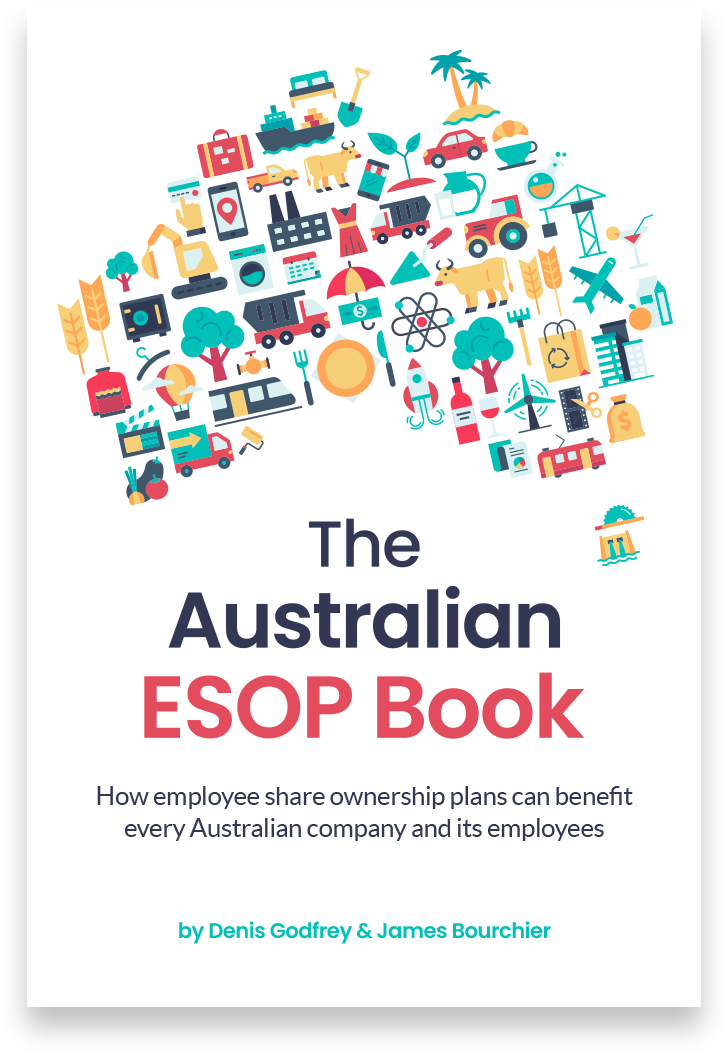Employees purchase shares in the company they work for with their pre-tax salary
This innovative approach takes away the barriers of other plans, allowing employees to purchase equity amounts that create a real ownership mindset, while the company enjoys cashflow benefits in its employment costs and increased opportunity for company tax deductions.
Advantages
- Lowest cost ESOP because “salary sacrifice” is used.
- Very beneficial for all stakeholders when the share price is rising.
- Flexible design can accommodate share price fall protection, purchase matching and discretionary bonus awards and retention awards.
- Advantageous and flexible tax treatment.
- Can be applied to as few or as many employee groups as desired.
- Can be settled in cash or shares.
- Could be structured as salary sacrifice Share Appreciation Rights in high grown scenarios.
- Non-dilutive; the full price of a Share is paid at the time of acquisition, from pre-tax salary sacrifice.
Disadvantages
- Only works in Australia.
- Requires compliance with “contribution plan” Corporations Act requirements (not onerous for listed companies), or an “AFSL arrangement” with a service provider.
- Requires education and engagement with workforce, as it is a very new kind of plan in Australia.
- The plan is subject to an annual licensing fee, however, if the share price is rising, the fee can be expected to be offset by improved company tax deductions and higher profitability.
The Share Save Plan™ encourages employees to invest in employer equity with option to get their invested cash back
ESOPs are a popular savings mechanism in the United Kingdom, which has legislated to support their use. While Australia has not, The Share Save Plan is highly effective under existing legislation. It has many of the same design features as the UK ESOPs and most of their benefits, including a cashback feature.
Design features
The main design features of the The Share Save Plan are:
- Participants elect amounts of monthly salary sacrifice.
- Each month the salary sacrifice amounts are recorded, and converted into allocations of Plan Shares on a quarterly basis (simplifies administration) using a share price which is either:
- the lower of:
- a volume weighted average price (VWAP) calculated over the quarter, or
- the closing price at which shares were traded on the ASX on the last trading day of the quarter,
or
- the VWAP for the quarter.
- the lower of:
- Participants are entitled to Dividend Replacement Plan Shares, which operate like a dividend reinvestment plan i.e. the value of cash dividends plus franking credits that would have applied if they had they been regular shares, are paid in the form of additional Plan Shares. This is akin to a salary sacrifice of dividends as tax is deferred.
- The Company may choose to match Salary Sacrifice Plan Shares with Matching Plan Shares. The Company needs to decide if matching is to occur and if so then the basis of the matching. Matching is a way of providing a discount to employees.
- Award Plan Shares may be offered as discretionary bonus to selected groups of employees, irrespective of whether or not they are participating in salary sacrifice.
- Conversion of Plan Shares that are not subject to vesting conditions or conversion restrictions, may occur at any time determined by the employee during employment up to 15 years after the Plan Shares are acquired. Conversion causes Plan Shares to be replaced in the discretion of the Board with either:
- ordinary fully paid shares in the Company (Shares), or
- a cash payment with a gross value equal to either:
- the then market value of the Plan Shares (same value as Shares), or
- the acquisition price of the Plan Shares – this alternative would only apply to Salary Sacrifice Plan Shares and is a plan design choice, it does not involve additional cost to the Company as the Company is simply repaying the amount salary sacrificed for the Plan Shares, however, it will provide significant risk protection for employees.
- The Shares acquired on conversion will initially be held in an employee share trust (EST) and the employee may choose to:
- Leave the Shares in the EST,
- Have the trustee of the EST sell the Shares and transfer the net sale proceeds to the employee, or
- Have the EST trustee transfer the Shares into the name of the employee.
- When a participant ceases to be an employee, Plan Shares will be automatically converted as described above.
- If a taxing point arises for Plan Shares during employment (at end of 15 year maximum tax deferral period), then they will be automatically converted as described above.
Design alternatives
Participation
There are no restrictions on how the company may define the group(s) of employees who are eligible to participate in this plan.
Matching
A commonly applied approach to matching is one for one which is akin to a 50% discount. A one of four matching represent a 20% discount etc.
Providing matching can improve participation rates by enhancing benefits for participants. Matching can also minimise the possibility of loss for employees from a fall in the share price (though the capital protection feature does this more effectively, if selected). Again, this can help improve participation rates.
Vesting Conditions
Vesting conditions are not appropriate for Salary Sacrifice Plan Shares. However, they may be appropriate for Matching Plan Shares or Award Plans Shares to ensure that the Company gets something in return for these discounts or bonuses.
Whether vesting conditions are attached to Matching or Award Plan Shares will depend upon the purpose of the grants. For example:
- If the grant is an award for past performance or service then it would be unlikely to have any vesting conditions, or
- If the grant were to help retain employees, then a service vesting period may be applied.
Conversion Restrictions
If the purpose of The Share Save Plan were to encourage long term holding of equity, then conversion restrictions may be attached to the Plan Shares to ensure that they are not converted into ordinary shares and sold in the short term. This is most likely appropriate for Matching Plan Shares or Award Plan Shares (it would generally not be appropriate to restrict salary sacrifice amounts).
Sources of Shares
When a Plan Share is converted the company needs to provide shares to the Plan Share holder. The shares may be sources via new issues or on-market purchases.
New issues are dilutive and involve no cash outflow whereas on-market purchases are not dilutive but involve cash outflow.
Which alternative is suitable for a company needs to be determined in the light of its particular circumstances.
Accounting
When Plan Shares are granted, the value will be calculated using accounting standard AASB2 for share-based payments and the expense may need to be amortised over a service vesting period, if any.
This expense does not qualify as a tax deduction for the Company.
Tax Deduction for Company
- On conversion of the Plan Shares into Shares the Company will contribute the then value of the Shares to an EST. The contribution qualifies as an income tax deduction for the Company. If the share price has increased the deduction will generate a cash flow gain for the company via the reduction in company tax.
- The EST may acquire the Shares via a subscription to a new issue or a market purchase as determined by the Board. Three situations may arise as follows:
| Conversion Share Price Compared to Acquisition Price | Comment on New Issue or Market Purchase |
|---|---|
| Conversion Share Price Below Acquisition Price | Market purchases advantage the Company as the cash out-flow is less than the amount of salary sacrifice. (Note: if capital protection applies, then cash settlement at the Acquisition Price would be used instead). |
| Equal | Neutral as to new issue or market purchase. |
| Conversion Share Price Above Acquisition Price | New issues avoid extra cost of market purchases above amount of salary sacrifice. |
Employee Taxation
On conversion of Plan Shares the participants will be taxed as follows, provided they do not own or control the voting of more than 10% of issued shares:
- If settled in cash, then they will be taxed on 100% of the amount received – mainly would apply if share price had declined since the Plan Shares were granted in respect of a salary sacrifice, which is expected to be an infrequent outcome over the long term,
- If settled in Shares, they will be taxed on 100% of the market value at the time of the conversion or if sold within 30 days of the date of conversion the participant will be taxed on the net sale proceeds. The outcome is equivalent to a 100% CGT discount, compared to on-market purchases up front. If Shares acquired on conversion of Plan Shares are subsequently sold more than 30 days after the conversion, then:
- 50% of the capital gain will be taxed, if the Shares have been held for more than 12 months,
- 100% of the capital gain will be taxed, if the Shares have been held for less than 12 months.
The outcome is equivalent to a 100% CGT discount, compared to on-market purchases up front.
Corporations Act Considerations
Disclosure obligations need to be fulfilled in relation to SSPs but they are not onerous.





